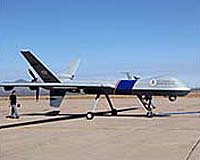| . |  |
. |
Edwards AFB CA (SPX) Jul 22, 2009 It's no secret that unmanned aircraft are widely used in today's war to provide information, surveillance and armed reconnaissance. What's not widely known is the evaluation process these aircraft go through before they are delivered to the warfighter. Members of Detachment 5 of the Air Force Operational Test and Evaluation Center here test the MQ-1 Predator and three versions of the RQ-4 Global Hawk under realistic combat conditions to inform decision makers on the capabilities of the aircraft. "We're going to set up scenarios on ranges and test complexes to stress the system," said Maj. Brian Maddox, the airborne signals intelligence payload test director. These scenarios involve operators, maintainers, pilots and intelligence personnel performing exercises to imitate real-world situations. These operational tests are where the system's effectiveness is determined and the results are evaluated to ensure Airmen and joint coalition partners get the capabilities they need to complete their mission today and tomorrow. "Airmen have been engaged in continuous combat for more than 18 years, and our Air Force is actively searching for ways to rapidly enhance our effectiveness at all levels," said Maj. Gen. Stephen T. Sargeant, the Air Force Operational Test and Evaluation Center commander. "The warfighter is demanding the entire acquisition community rapidly develop, test and field urgently needed and often increasingly complex weapon systems, like the UAS." The Global Hawk is becoming increasingly complex as its capabilities are increased. Detachment 5 members test these capabilities on three versions: the Global Hawk Block 20, 30 and 40. Block 20 is an improvement on the Block 10 airframe, a proven intelligence, surveillance and reconnaissance weapons system. The Block 20 has an increased wingspan of almost 15 feet, increased payload capacity of 1,000 pounds, new sensor capabilities and a new generator providing up to a 150 percent increase in electrical power. The Block 30 aircraft carries the airborne signals intelligence payload that will increase battlefield signal collection capabilities, situational awareness and intelligence gathering across large areas of land. The Block 40 version incorporates the multiplatform radar technology insertion program that provides high fidelity ground moving target indication and high quality radar imagery. "The level of technology that we're at is now game changing," said Maj. Paul Wojtowicz, a test division UAS pilot for AFOTEC. "We can have an aircraft go and fly an entire 30-plus-hour mission almost hands off, return and taxi in. (The RQ-4) is an amazing bit of technology." Major Wojtowicz began his career flying the C-5 Galaxy then became an instructor pilot before he was assigned to Detachment 5. "It's a lot different and not necessarily as easy as everyone would assume because it poses a lot more challenges when you're flying from the ground with a mouse, not even with a stick," Major Wojtowicz said. Major Maddox agreed, but they both realize the importance of the UAS test mission. Major Maddox has flown the C-130 Hercules, F-15E Strike Eagle, the U-2 and a hand full of trainers and realized that with UAs he had to change the way he thought about flying. "I'm not yanking and banking in my F-15, but I'm doing an important job," Major Maddox said. "As servicemembers, you have to kind of get away from that fighter pilot mentality and look at the bigger picture. You talk to some of the Army Soldiers and they say that the (UA) has saved their behind." Detachment 5 consists of a team of Airmen and contractors dedicated to improve the unmanned aircraft to minimize risk and save coalition force's lives by ensuring they are fully capable. "The fact that you can actually influence the design, make it better before it gets out to the warfighter is deeply satisfying," said Keith Sanders, the technical adviser for AFOTEC Detachment 5. "Knowing that system is better because of what our team both developmental and operational--have done together to improve it is satisfying," Mr. Sanders said. "Hopefully, once it gets out there it will absolutely exceed the warfighters needs." AFOTEC currently operates five detachments and 12 operating locations across the United States. Share This Article With Planet Earth
Related Links USAF Operational Test and Evaluation Center UAV News - Suppliers and Technology
 Pakistani minister slams US drone strikes
Pakistani minister slams US drone strikesParis (AFP) July 21, 2009 Pakistan's interior minister, Rehman Malik, on Tuesday attacked the United States' ongoing bombing campaign against suspected militant leaders in his country. US military and intelligence agencies fly pilotless aircraft over areas along Pakistan's border with Afghanistan, firing missiles at targets suspected of links to the Taliban or to Al-Qaeda leader Osama bin Laden. Pakistan, which ... read more |
|
| The content herein, unless otherwise known to be public domain, are Copyright 1995-2009 - SpaceDaily. AFP and UPI Wire Stories are copyright Agence France-Presse and United Press International. ESA Portal Reports are copyright European Space Agency. All NASA sourced material is public domain. Additional copyrights may apply in whole or part to other bona fide parties. Advertising does not imply endorsement,agreement or approval of any opinions, statements or information provided by SpaceDaily on any Web page published or hosted by SpaceDaily. Privacy Statement |